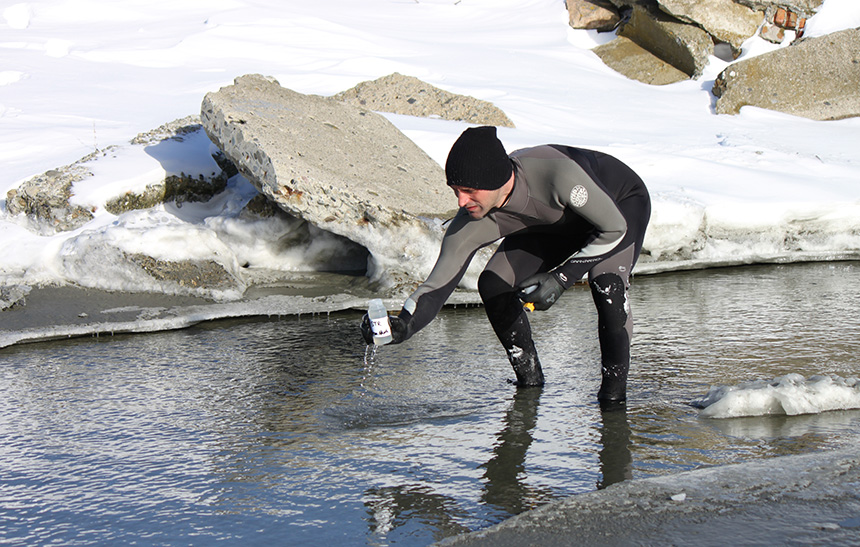Shea Students Build Sustainable Tiny Home for Veteran
January 22, 2021
PAWTUCKET, R.I. — What was once a beat-up shipping container is now a home.
The 40-foot-long metal box sits on a grassy patch next to Jenks Middle School on Division Street. It’s not too far from its original home in the Port of Providence, but since its relocation, it has undergone quite the transformation.
The wavy, slate gray metal shell is broken up by a French door that opens to a view of McCoy Stadium across the street. Inside, wood paneling lines the walls of a living room, kitchen space, bathroom, and soon-to-be bedroom.
Kevin Cunha and Donovan Reid are in the kitchen, talking about a drop-down table that will be installed and pointing out the solar-powered features of the space.
“The house can last three days without sunlight, and then there’s a horizontal wind turbine that can create up to 1,500 watts as backup,” Cunha said.
The house is meant to be entirely self-sufficient — it features solar panels, rain barrels, a water purifier, and the aforementioned wind turbine — and once completed, will be moved to Dare to Dream Ranch, a veterans organization in Foster, and gifted to a homeless veteran.
But this tiny, sustainable home is more than just a feel-good project for Cunha and Reid, who both have backgrounds in manufacturing and engineering; it’s also serving as a hands-on learning lesson for the 30 Shea High School students who are helping to build it.
“They did all this,” said Reid, gesturing around him.
The tiny home at Jenks Middle School is one of a series of projects that students have worked on through The Center for Dynamic Learning, a Providence-based program that Cunha and his wife, Beth, started in 2003.
“I started off actually at Roger Williams Middle School in Providence, and my first project with the kids was building see-through, bulletproof skateboards,” Cunha said. “We call what we do STEAMM education, so it’s science, technology, engineering, art, math, and manufacturing.”
Cunha was a self-proclaimed “bad kid” growing up, but later found purpose and passion in using his hands to build and create.
“When I was a kid, I was always in trouble,” he said. “But I got lucky.”
A chief engineer for the Coast Guard took Cunha under his wing, taught him to work with his hands, and showed him that he could do great things if he put his mind to it.
“I was, like, never in trouble again and went from being a D student to an A student, and I fell in love with engineering,” he said.
That moment has stuck with Cunha and inspired him to pass on what he gained through hands-on learning. And it works.
“We usually pre- and post-assess the kids when they enter our program,” he said. “Usually, their scores go up about 25 to 30 percent in math literacy. Like this class right now, they had very low scores when I first got them, and they’ve gone up exceptionally.”
One student in Cunha’s current class is Giovanni Santiago, a 17-year-old Shea High School senior who helped build the group’s first tiny home this summer and is helping with the one at Jenks.
For Santiago, building these tiny homes has been not only academically rewarding, it has also shown him how he can give back to the community. It has helped him see a future for himself, too.
“It’s a whole different way of learning,” he said. “It’s like you’re actually bringing life into a situation. I’ve fixed little things at home but nothing really as serious as what I’m doing now. Now I’ve put in a whole ceiling, set up sinks, a whole bunch of things I never knew before and now can use in the future.”


The craftsmanship in the tiny home at Jenks is impressive: the drop ceiling that is being installed is almost complete; the corrugated metal in the bathroom hints at the shipping container’s utilitarian past, a design choice by the students; and a fold-down table in the kitchen shows their ingenuity. The latter is something that Santiago is particularly proud of.
“We created this table that was going into the tiny house, but it was a table that can be moved around. So, there is a switch that we created that allows the table to drop down,” Santiago said. “It’s just a whole different away of learning. I would like to continue doing it after, because I know that it will help me in the long run.”
Seeing students learn and thrive while helping the community is a win-win for Cunha.
As a parent of two sons who are in the military, seeing homeless veterans cast aside by society hurts. And as a former self-proclaimed “bad kid,” Cunha knows that for a lot of students, just having someone to believe in you can make a difference.




What an inspiring article
If more young people were aware of the people in this Country that struggle without housing like the Students at Shea…so many that live everyday without a
roof over their heads/a place to cook and shower and just have a space to read and write and sleep what a different attitude this Country might be displayed..Giving and not taking and wanting..Very wonderful attribute on the students at Shea.
Teaching Construction outwits Destruction every time!! SHEA (Skilled Honorable Empowered Achievers) students continue to do amazing things!
This is such a great article. Kudos to Mr. Cunha and Mr. Reid and Shea High School
Please pm me. I have a small business and would love to help
Hi Eleanor,
Thank you so much for your kind words. I can be reached by email at [email protected]. Hope to hear from you soon.
Kevin Cunha, PE
401-461-1813
This is a GREAT idea. Not every kid is college bound or wants to be. There are plenty of high paying jobs in the "trades" and a severe shortage of those with the skills. We need more of this training in our schools and we need more technical high schools like Diman in Massachusetts instead of pushing college for all.